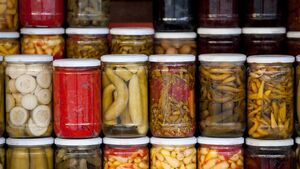You can do lots with veg that people would throw away

Photo for illustrative purposes only
WHILE I’m always sad to see the end of T-shirts and shorts and long days, this year brings a climax to the summer’s riches – so much, in fact, that the problem is not what to pick, but what to do with the surplus.
Remember that you can pickle cucumbers and gherkins, of course, but you can also pickle any number of other things, including broccoli, cauliflower, carrots, onions, garlic and many other vegetables.
The pickling mix will vary depending on the vegetable, but for most of them, you can boil white vinegar with peppercorns, let it cool, and then add herbs, dill, garlic, and mustard powder. Then you can seal it in a mason jar and put it in a boiling-water bath for a few minutes to kill off any germs.
I personally love apple chunks pickled in cider vinegar, with some cinnamon, cloves, and cardamom added.
I would also personally recommend recipes for ‘Indian pickle’, which became popularised from Indian immigrants in South Africa and elsewhere.
One thing to remember is that you can do a lot with parts of vegetables that most people throw away.
“Greens,” the tough leaves from brassicas like Brussels Sprouts, can be wonderful when chopped finely and sautéed.
Or they can be dried and used later: dehydrated vegetable stems and outer leaves can be kept for soup broth; citrus peels can be zested and the zest used as a spice, while the rinds can be put into marmalade; apples can be made into a dried snack.
Don’t forget to ferment some of your harvest as well; this is the time to turn your cabbage into sauerkraut or kimchi.
If you’ve never done this before, this is the season to try it, as there is a lot of garden material to work with.
Most gardeners dig up their potatoes for winter, but they can be kept in root cellars. Farmers used to pile up potatoes in “clamps,” cover them with earth and straw, with only a short, wide tube poking through at the top to allow the potatoes to breathe.
You can keep most root vegetables in boxes of sand in the basement – carrots, beetroot, turnips – and they will usually keep all winter.
Autumn, of course, is the season for gathering fruits both wild and domestic. If you have fruit trees, check them every day to pick the ripe fruits, and don’t let any fruits linger on the ground, or you’ll attract wasps.
Elderberries are swelling rapidly on the vine, and when they turn purple in a week or two you can snip off the cluster and gently remove the berries with a fork.
Blackberries, also, are appearing all along the hedgerows, and will be darkening one by one over the next month – try to get them before the first frosts.
You can use berries for jam by washing them off, measuring their volume in measuring cup and then boiling them in only a little water, just enough to make them tender – perhaps as much volume as the berries themselves.
Add as much sugar as you did elderberries, pouring in slowly and stirring to make sure it dissolves. Unless you mix the berries with apples or some other high-pectin fruit, you will also need to add a spoonful of store-bought pectin.
Keep boiling it until it begins to set. To test if it has set properly, dribble a little jam on a saucer, let it cool and then poke it with your finger, and see if it wrinkles.
You can also make elderberries into syrup — like jam, but with less sugar and no pectin for a liquid stock, and add a little syrup to glasses of ate throughout the winter.
Don’t forget to start thinking about next year – to uproot and compost plants that are spent, to remove weed roots that might lurk underground until next year, and to lay down manure or empty your compost into the garden to ready it for new material over the winter.
This is also the time to give away part of your garden to the neighbours in exchange for later favours, or to older neighbours who could use some fresh food over the winter – and possibly even some conversation as well.
All these practices are good to learn now, for as the year has proven, we don’t know what’s coming in the future, and it’s best to not only stock up, but also develop the skills to do so.





